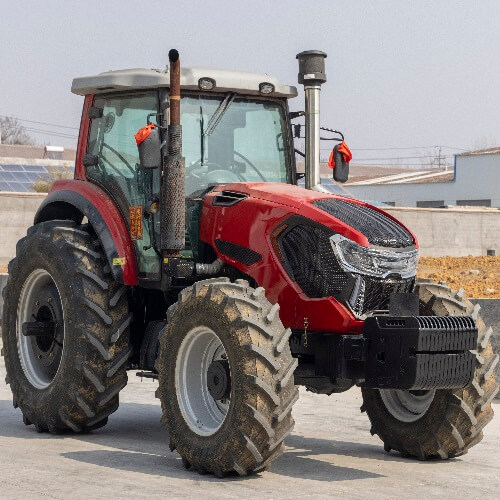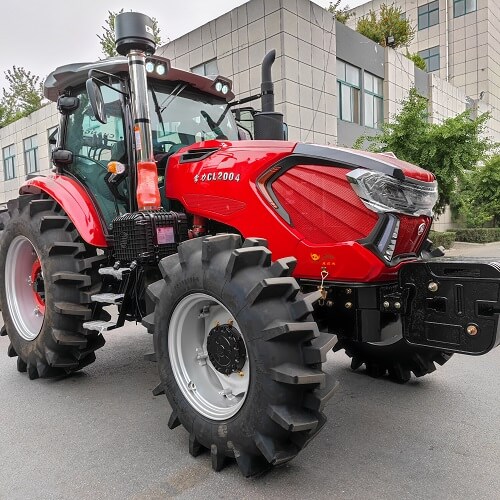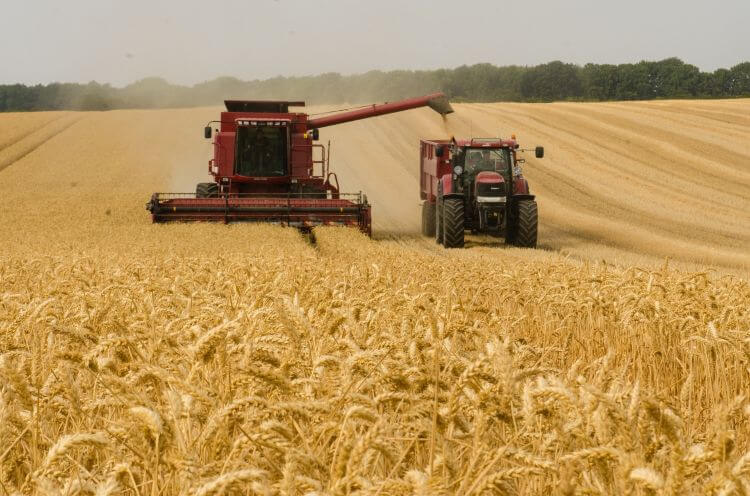Choosing the right tractor power is one of the most critical decisions a farmer can make when investing in farm machinery, and in this article, I’ll take a look at how horsepower needs change depending on the size and type of farm. Whether you manage a small family farm or oversee the operations of a large commercial plantation, understanding how to meet your needs with the right machinery can save you money, increase efficiency and maximize production. From compact tractors to high-powered 4×4 behemoths, we’ll give you all the information you need to make an informed decision.
So how exactly should farmers decide on the horsepower of their next tractor? The answer lies in carefully evaluating the size of your land, terrain, type of task and frequency of operation. a 20-50 horsepower compact tractor may be perfect for a small farm to handle light tillage, mowing or gardening, while a large commercial farm may need more than 200 horsepower for heavy tillage, plowing and multi-tool work. Additionally, the type of attachments you plan to use (such as loaders, balers or planters) will also greatly affect horsepower needs.
As agriculture continues to modernize, choosing the right farm equipment is no longer just about horsepower. It’s about sustainability, versatility and productivity. Wondering how the size of your farm translates into specific power needs? Wondering if you should upgrade or downsize your existing machinery and equipment? Here we’ll break down the realities, tractor categories and usage tips to give you a solid foundation for choosing the right equipment for your farm’s unique requirements.
Contents
- 1 Understanding Horsepower and Its Role in Agriculture
- 2 Scenarios Based on Farm Size:
- 3 Terrain and Soil Type Considerations
- 4 Matching with Implements
- 5 Cost Considerations and Fuel Efficiency
- 6 Financing, Leasing & Long-Term Planning
- 7 Forward Thinking Questions:
- 8 Future-Proofing Your Investment
- 9 Case Studies
- 10 Conclusion
Understanding Horsepower and Its Role in Agriculture
Horsepower (HP) is the standard metric used to gauge a tractor’s ability to perform work. In agriculture, horsepower influences everything from the depth of your tillage to how quickly you can pull a baler through a field. While it may be tempting to simply choose the most powerful tractor you can afford, excessive horsepower can lead to overspending on fuel, larger upfront costs, and unnecessary wear on attachments.
A better approach is to match the horsepower to your actual workload. Underpowering results in sluggish performance, stalling under load, and possible engine damage. Overpowering can lead to inefficiencies in fuel usage and difficulty maneuvering on small or delicate fields.
Scenarios Based on Farm Size:
Farm Size Scenarios: Matching HP with Acreage
Small Farms (0–10 acres)
- Recommended Horsepower: 20–50 HP
- Key Tasks: Mowing, light tilling, hauling small trailers, snow removal, gardening
- Ideal Tractor: Compact tractors
Pain Point: Small-scale farmers often overspend on larger machines thinking it will “future-proof” their farm. In reality, large tractors are harder to maneuver and waste fuel.
Solution: Choose compact, fuel-efficient tractors with multi-use attachments. They are affordable, easy to store, and perfect for tight maneuvering in orchards or vegetable plots.

Medium Farms (10–100 acres)
- Recommended Horsepower: 50–100 HP
- Key Tasks: Light tillage, hay baling, manure spreading, small implement pulling
- Ideal Tractor: Utility tractors
Pain Point: Farmers in this bracket often struggle to find a balance between versatility and budget. They may try to use underpowered tractors for tasks like round baling, resulting in mechanical strain.
Solution: Invest in utility tractors with a strong PTO rating and hydraulic capacity. These machines are powerful enough for tough jobs but still affordable and maneuverable.

Large Farms (100+ acres)
- Recommended Horsepower: 100–300+ HP
- Key Tasks: Deep ripping, heavy seeding, subsoiling, multi-implement towing
- Ideal Tractor: Row crop tractors, articulated 4WDs
Pain Point: Large-scale farmers face downtime risks when tractors lack the power to handle complex, high-torque implements. Improper matching of power to attachments results in inefficiency.
Solution: Choose high-horsepower tractors equipped with GPS guidance, auto-steer, and high hydraulic output for simultaneous multi-tasking.

Terrain and Soil Type Considerations
Terrain and soil types play a pivotal role in determining the appropriate horsepower and traction requirements of your tractor. Different land conditions present varying levels of resistance and maneuverability challenges that must be matched with the right equipment specifications.
- Flat, sandy land: This type of terrain presents minimal resistance to traction and tool movement. Tractors operating on flat sandy fields often require lower horsepower because the soil offers less drag. These fields allow for greater fuel efficiency and can be worked with lighter machines, making compact or mid-sized tractors more suitable.
- Clay or rocky soil: Heavier and more compacted soils like clay, or those interspersed with rocks, present a significant challenge. They resist tillage and create high drag, meaning your tractor must exert more force to perform the same tasks. In these conditions, higher horsepower is essential, not just for pulling implements effectively, but also for maintaining operational speed and avoiding equipment strain.
- Hilly or uneven terrain: Operating on slopes or undulating landscapes increases the demand on both traction and stability. Tractors in such environments benefit greatly from 4WD systems, as these provide the torque necessary to ascend inclines without wheel slippage. Additionally, more horsepower is needed to overcome gravitational resistance, especially when carrying loads uphill or braking on descents.
Pro Tip: Never base your tractor choice solely on flat-ground performance. Farms with mixed elevation require machines with additional torque and stability features. Underpowered tractors on hills not only struggle with traction but also suffer from increased wear, overheating, and higher fuel usage during climbs.

Matching with Implements
The power demands of your tractor are not just about the tractor itself—they are heavily influenced by the implements you intend to use. Every attachment has specific requirements that affect your need for PTO horsepower, hydraulic capacity, and engine torque.
- Rotary tillers: These require stable, mid-range horsepower with smooth RPM delivery to ensure effective soil mixing without engine overload. A tractor that cannot maintain consistent speed and torque may cause uneven tilling or premature wear.
- Front loaders and backhoes: These attachments draw heavily on hydraulic systems and need a tractor with robust frame support and high hydraulic flow rates. Insufficient pressure can slow down movement or lead to stalling under load.
- Baling and drilling equipment: These require high and consistent PTO horsepower to operate efficiently. A tractor without adequate PTO torque may fail to keep up with baler feed rates or struggle when drilling in dense or uneven ground.
- Planters and sprayers: While less demanding than tillage equipment, these tools still require careful PTO calibration and smooth engine operation for precise output.
Checklist: Create a complete list of current and planned implements, noting each one’s power, hydraulic, and PTO needs. Compare those needs against the tractor specifications you’re considering. Mismatches will not only reduce efficiency but can also damage both the tractor and the attachment over time.
Cost Considerations and Fuel Efficiency
- High HP = higher fuel consumption, but also higher productivity per pass.
- Compare cost-per-acre efficiency, not just total fuel expense.
Example: A 200 HP tractor may cost more per hour to operate but finish the task in half the time of a 90 HP unit—saving fuel and labor in total.
Budget Tips:
- Evaluate resale value: Higher HP tractors tend to retain value longer.
- Consider telematics and fuel-optimized engines to reduce long-term costs.
Financing, Leasing & Long-Term Planning
Financing a tractor is more than a short-term transaction—it’s a strategic investment that affects your farm’s operational agility and future growth. There are several financial pathways and planning considerations that can shape the long-term value of your purchase.
- New vs. Used: Buying a used tractor in good condition can offer excellent cost savings and allow you to acquire a higher horsepower model within your budget. However, used equipment should be thoroughly inspected, especially for engine wear, PTO alignment, and frame integrity.
- Leasing: Leasing is an effective strategy for farmers who need specific equipment for a short season or want to test the viability of new technologies like GPS-guided or electric tractors without a full upfront commitment. Leases often include maintenance, which can lower repair costs during the term.
- Subsidies and Grants: Many local and national governments offer financial support for purchasing mechanized equipment, especially when tied to sustainability, emissions reduction, or technology adoption. These subsidies can significantly reduce initial costs, particularly when upgrading from outdated or fuel-inefficient models.
Forward Thinking Questions:
- Are you planning to expand your land holdings or increase crop diversity in the next few years?
- Do you expect to add new livestock operations that will change the type of fieldwork required?
- Will your farm transition to smart agriculture with sensors, drones, or precision planting systems?
Answering these questions helps ensure your tractor investment remains useful for the next 5–10 years, aligning with future goals rather than current limitations.
Future-Proofing Your Investment
- Scalability: Ensure the tractor model you choose can accommodate growth, both in farm size and operational scope.
- Modular Attachments: Opt for tractors that support a wide range of standardized hitches and PTO configurations. This adaptability will help you adjust as tasks and seasons change.
- Digital Capabilities: Look for options with GPS compatibility, telematics integration, and smart dashboard systems. These features enhance operational precision and ease of maintenance tracking.
Case Studies
Asian Rice Farm: Deployed a 240 HP 4WD, improving sowing consistency and reducing planting window by 3 days.
Oregon Orchard: Swapped a 35 HP compact for a 45 HP model, reducing mowing time by 25%.
Midwest Grain Farm: Upgraded to a 160 HP tractor; tillage efficiency increased 40%.

Conclusion
Choosing the right tractor power is a strategic decision that directly impacts your farm’s efficiency and output. Whether you’re managing a small hobby farm or a large-scale commercial operation, understanding how to assess your needs and translate them into horsepower can help you invest wisely. Don’t forget to factor in your terrain, equipment attachments, and long-term farming goals.
For farmers seeking dependable, high-performance machinery, MINNUO offers a range of expertly designed tractors and farm equipment tailored for different operations and environments. With decades of industry experience and a focus on quality and support, MINNUO’s specialized services are worth considering for any growing agribusiness!

